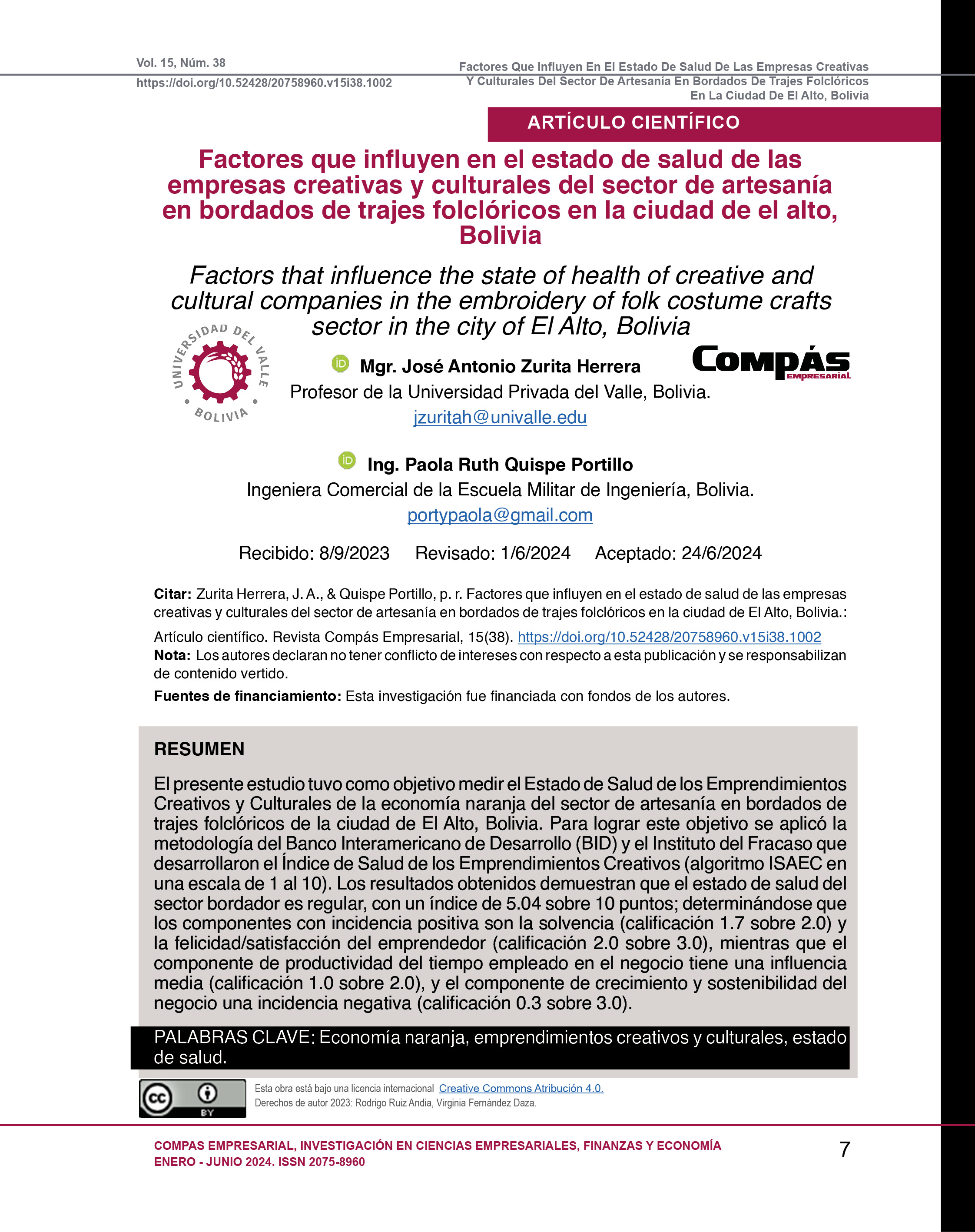FACTORS THAT INFLUENCE THE STATE OF HEALTH OF CREATIVE AND CULTURAL COMPANIES IN THE EMBROIDERY OF FOLK COSTUME CRAFTS SECTOR IN THE CITY OF EL ALTO, BOLIVIA.
Scientific article
DOI:
https://doi.org/10.52428/20758960.v15i38.1002Keywords:
Orange economy, creative and cultural ventures, health condition, financial healthAbstract
The objective of this study was to measure the State of Health of the Creative and Cultural Entrepreneurships of the orange economy of the craft sector in embroidery of folk costumes in the city of El Alto, Bolivia. To achieve this objective, the methodology of the Inter-American Development Bank (IDB) and the Failure Institute, which developed the Creative Entrepreneurship Health Index (ISAEC algorithm on a scale of 1 to 10), was applied. The results obtained show that the state of health of the embroidery sector is regular, with an index of 5.04 out of 10 points; It was determined that the components with a positive impact are solvency (score 1.7 out of 2.0) and happiness/satisfaction of the entrepreneur (score 2.0 out of 3.0), while the component of productivity of the time spent in the business has a medium influence (score 1.0 out of 2.0), and the growth and sustainability component of the business has a negative impact (score 0.3 out of 3.0).
Downloads
References
Agencia Municipal de Noticias. (13 de junio de 2022). Movimiento económico de la fiesta de Gran Poder. AMUN.
Benavente, J. M., & Grazzi, M. (2017). Politicas publicas para la creatividad y la innovacion: impulsando la economia naranja en america latina y el caribe. Banco Interameriocano de Desarrollo.
Cámara de Industria, comercio, servicios y turismo de Santa Cruz - Bolivia [CAINCO]. (8 de Noviembre de 2018). Obtenido de https://www.cainco.org.bo/empresaydesarrollo/2018/11/08/economia-naranja-cuando-la-economia-tiene-un-color/
Gasca, L., & Luzardo, A. (2018). Emprender un futuro naranja. Banco Interamericano de Desarrollo.
Humberto Charlies; Jhonatan Aguirre; Rogelio Sanches. (2022). Satisfacción laboral de los emprendedores , retos y beneficios. SCIELO, https://www.scielo.org.mx/scielo.php?script=sci_arttext&pid=S0186-10422021000300006.
La Razon. (21 de mayo de 2021). Sopocachi y la economia naranja. La Razón.
Luzardo, A., Jesús, D. d., & Pérez, M. (2017). Economía naranja, Innovaciones que no sabías que eran de América Latina y el Caribe. Banco Interamericano de Desarrollo.
https://doi.org/10.18235/0000723
https://doi.org/10.18235/0000723
https://doi.org/10.18235/0000723
https://doi.org/10.18235/0000723
https://doi.org/10.18235/0000723
https://doi.org/10.18235/0000723
https://doi.org/10.18235/0000723 DOI: https://doi.org/10.18235/0000723
NOMADAQ. (2022). Cholets creatividad arquitectónica que crea identidad en Bolivia. NOMADAQ.
Price, J. J., & Mujica, F. (2018). Matchfunding, una alternativa de financiamiento para las industrias. Banco Interamericano de Desarrollo (BID). https://doi.org/10.18235/0001554 https://doi.org/10.18235/0001554
https://doi.org/10.18235/0001554 DOI: https://doi.org/10.18235/0001554
Restrepo, F. B., & Márquez, I. D. (2013). La economía naranja, una oportunidad infinita. Banco Interamericano de Desarrollo.
Sampieri Hernandez. (2014). metodologia de la investigacion. Graw Hill Education.
UNESCO. (2010). Políticas para la creatividad: guia para el desarrollo de industrias culturales y creativas. Paris.

Published
How to Cite
Issue
Section
License
Copyright (c) 2024 JOSE ANTONIO ZURITA HERRERA, Paola Ruth Quispe Portillo

This work is licensed under a Creative Commons Attribution 4.0 International License.
Authors who publish with this journal agree to the following terms:
- Authors retain copyright and grant the journal right of first publication with the work simultaneously licensed under a Creative Commons Attribution License 4.0 that allows others to share the work with an acknowledgement of the work's authorship and initial publication in this journal.
- Authors are able to enter into separate, additional contractual arrangements for the non-exclusive distribution of the journal's published version of the work (e.g., post it to an institutional repository or publish it in a book), with an acknowledgement of its initial publication in this journal.
- Authors are permitted and encouraged to post their work online (e.g., in institutional repositories or on their website) prior to and during the submission process, as it can lead to productive exchanges, as well as earlier and greater citation of published work.









